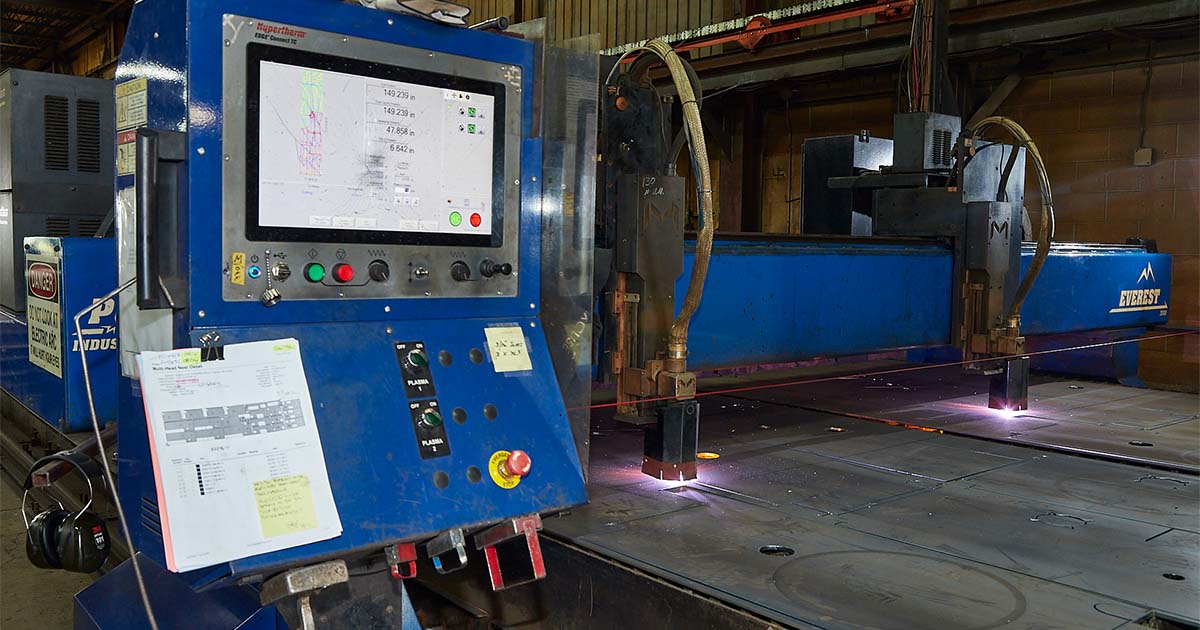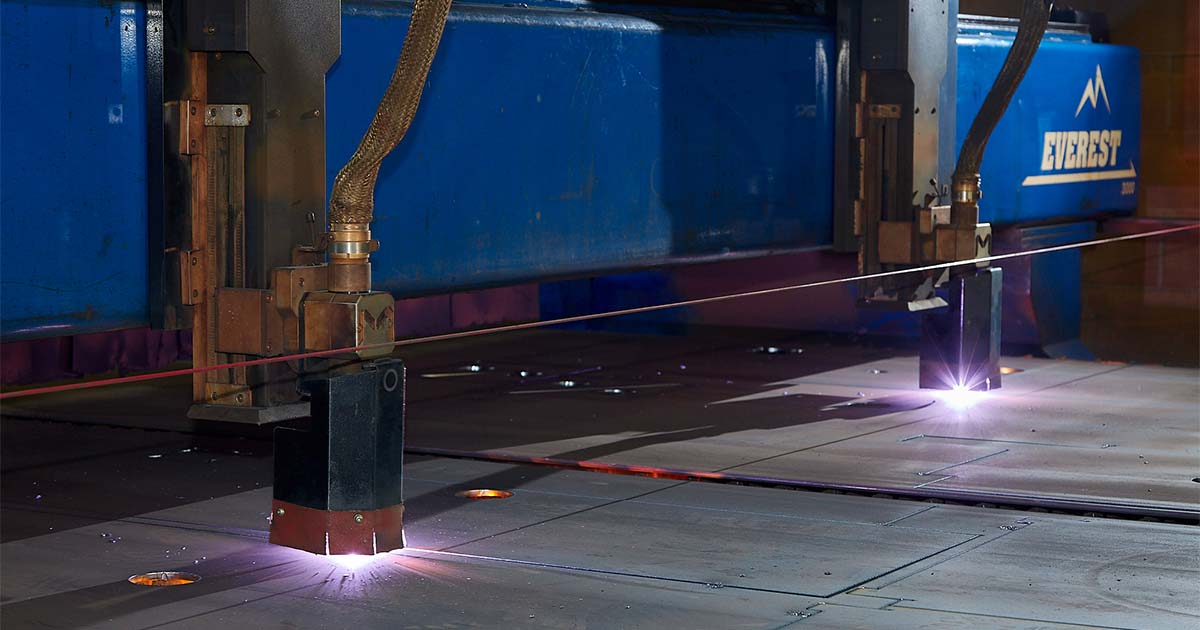
We collect basic website visitor information on this website and store it in cookies. We also utilize Google Analytics to track page view information to assist us in improving our website.

Plasma cutting is a balancing act of precision and durability, orchestrated by electrodes and nozzles. These critical components are the conductors of electricity, creators of intense plasma arcs, and tuners of gas flow. They do all this while withstanding extreme conditions.
In this article, we delve deep into the intricacies of plasma cutting consumables, demystifying the essential components that make this process a remarkable force in the realm of metal fabrication.
But why should you care about the intricacies of plasma cutting consumables? The answer lies in the quality, efficiency, and cost-effectiveness of your projects. Your knowledge of these components can lead you to the right cutting service provider, ensure superior quality in your endeavors, and potentially save you money in the long run.
At Amber Steel, we specialize in laser, plasma and flame cutting, and have always been a "total source" service for the production of quality steel products. Quality is achieved by utilizing the right production technique for the right product. Our continual investment in equipment and technology enables us to offer clients many production alternatives to achieve exact product specifications and tolerances. If you’re interested in learning more about steel cutting or have a project in mind that you would need our expertise on, do not hesitate to reach out. We’re always one email or phone call away.
Plasma cutting is all about harnessing the power of electrical arcs.
By creating a controlled electrical arc between an electrode and the workpiece, a high-temperature plasma jet is generated, reaching staggering temperatures exceeding 20,000°C. This intense heat transforms metal into molten form, making it susceptible to precise cutting.
One of the defining characteristics of plasma cutting is its reliance on electrically conductive materials. Metals like stainless steel, copper, and aluminum are ideal candidates for this process. However, plasma cutting can't penetrate non-conductive materials such as stone or glass.
Plasma cutting stands out when compared to alternative cutting methods, especially in terms of speed, precision, and material suitability.
Speed and Efficiency: Plasma cutting outpaces traditional flame cutting, particularly for thin metal sheets. Its speed can reach remarkable levels, up to 5 to 6 times faster than gas cutting.
Cutting Thickness: For those dealing with thick materials, high-power plasma cutting shines, as it can effortlessly handle thicknesses up to 150mm. In contrast, flame cutting remains the preferred choice for thicker materials.
Precision and Quality: When it comes to precision and minimal thermal deformation, plasma cutting takes the lead. The latest fine plasma cutting machines can achieve cutting accuracy akin to laser cutting, ensuring top-notch results.
Material Suitability: Plasma cutting boasts versatility across a wide range of metals, especially non-ferrous ones like stainless steel, aluminum, and copper. On the other hand, flame cutting primarily caters to carbon steel.
Now, let's dive into the core of our discussion ‒ the consumables that play an important role in the world of plasma cutting.
Electrodes and nozzles are unsung heroes in the plasma cutting process. These critical components endure extreme temperatures and inevitably wear out over time. The quality and condition of electrodes and nozzles directly influence the precision and quality of your cuts. Regularly replacing these consumables is imperative to maintain peak performance.
In addition to electrodes and nozzles, the choice of gas is another vital aspect of plasma cutting. Various gases, such as argon, nitrogen, air, oxygen, and hydrogen-argon mixes, offer specific effects on cutting quality, speed, and consumable lifespan. Selecting the right gas is paramount to optimizing cutting cost and efficiency.
Electrodes in plasma cutting systems are responsible for conducting electrical current, creating the essential plasma arc. This arc, formed by ionizing the cutting gas, is the key to precision metal cutting.

Within the world of plasma cutting, different electrodes cater to specific cutting environments and requirements:
Hafnium Electrodes: Modern plasma cutting systems frequently employ electrodes containing hafnium. Hafnium, with its high melting point, proves invaluable in sustaining the arc, whether in air or oxygen cutting environments.
Copper or Copper/Silver Composite Holders: These holders play a vital role in securing the emissive element, hafnium, in place within the electrode structure.
Variations Abound: Depending on the plasma cutting system and the demands of the cutting process, various electrode types are available. Their selection hinges on factors like the material being cut and the desired cut quality.
Cutting Environment: The chosen cutting environment, whether air or oxygen plasma cutting, significantly impacts electrode wear. Each environment exerts distinct effects on the electrode's longevity.
Electrode Material: Hafnium content plays a big role in the durability and performance of electrodes at high temperatures.
Cutting Parameters: Factors such as current settings, cutting speed, and the metal's type affect the rate at which electrodes degrade over time.
Quality of Consumables: Overall consumable quality, encompassing the electrode, wields a direct influence over both performance and lifespan.
Routine electrode inspections are vital to sustain optimal cutting performance and quality. Replace electrodes promptly when signs of wear emerge.
In selecting the ideal electrode for your plasma cutting requirements, a thoughtful evaluation of factors such as the material to be cut, cutting environment, and system specifications is essential. Regular maintenance and timely electrode replacement are essential practices to maintain peak performance and extend the longevity of the plasma cutting process.
In a plasma cutter, the nozzle plays a crucial role in focusing the plasma arc and the surrounding gas.
This precise focus is the key to achieving clean and accurate cuts. The nozzle's role is to ensure even distribution of the shielding gas around the plasma jet, contributing to a stable and clean cutting process.
Single Gas Nozzles: These nozzles rely on a single gas for plasma generation and cooling, as well as shielding the cutting area.
Double Gas Nozzles: Double gas nozzles use two different gases - one for creating plasma and the other to shield the cutting area from external influences.
Vortex Nozzles: Vortex nozzles guide the gas in a swirling motion around the central opening. This stabilizes the plasma jet, optimizing the cutting process.
Conical Nozzles: Conical nozzles feature a tapered opening that results in a more focused plasma jet, making them ideal for precision cuts and intricate details.
High-Definition (HD) Nozzles: HD nozzles are designed for specialized plasma cutting systems that demand higher cutting quality and tighter tolerances.
The correct pairing of electrodes and nozzles has a direct bearing on cut quality, process efficiency, and the durability of consumables.
For example, a worn or improperly sized nozzle can lead to a less focused plasma arc, causing wider cuts (kerf) and diminished cut quality. Similarly, an electrode exhibiting significant wear, such as a deep pit in the hafnium insert, can compromise the cutting process, making it challenging to achieve effective cuts and potentially harming other components within the torch.
Regular inspections and diligent maintenance of both electrodes and nozzles are imperative. This entails thorough checks for wear or damage, ensuring accurate installation and alignment, and prompt replacement when necessary. Often, it is advisable to replace both the nozzle and electrode concurrently to ensure optimal performance, rather than pairing a new electrode with a worn nozzle, which could hinder cutting results.
Ultimately, achieving high-quality plasma cutting requires the proper combination and maintenance of electrodes and nozzles. To extend the lifespan of these consumables and achieve superior cutting results, consistent assessments and timely replacements are essential.
Knowing plasma cutting consumables is more than just technical know-how – it's the key to better results.
Here's the rundown on why this matters to you:
Choosing Your Cutting Service Wisely: Understanding consumables helps you pick a cutting service that knows its stuff. A team well-versed in electrodes and nozzles is more likely to nail your project with precision and keep it within budget. It’s about getting what you pay for and then some.
Quality of Your Final Product: The right consumables make a world of difference in the final outcome. Different materials and their thicknesses need the right electrode and nozzle pair to shine. A savvy service provider doesn’t just pick the right tools; they know how to make the most of them. This means cleaner cuts, less waste, and a product that looks and functions as it should.
Cutting Costs, Not Corners: Knowing your way around consumables can be a ticket to cost savings. A provider who knows their gear can recommend choices that keep quality high but bring costs down. Think longer-lasting consumables or faster cuts to save on labor. It's about smart spending for smart results.
While the details of plasma cutting consumables might not be top of your mind, a bit of insight here can guide you to the right service, ensure top-tier quality, and maybe even save some cash. It's about ensuring your project hits the mark for quality and cost, backed by the best in the business.
Plasma cutting consumables have a major impact on the cut quality and overall efficiency of your product. Regular checks, correct pairings, and timely replacements are foundational for top-notch performance in plasma cutting.
But it's not just about keeping the process going. Quality consumables mean more precise cuts, less downtime, and a longer life for your plasma cutter. They're a big part of our promise for consistent, top-quality cuts in every job we do.
We're open for business, ready to tackle any plasma cutting challenge you have, big or small. Our team's geared up to tailor our solutions to your specific needs, always aiming for the highest quality.
At Amber Steel, we're not just about plasma cutting – we offer laser and flame cutting too. We've always been your one-stop shop for top-grade steel products. The right technique for the right product is our mantra, and continual investment in our gear and tech means we give you more options to meet your precise needs and tolerances. Interested in steel cutting, or have a project in mind? Just reach out. We're just an email or call away, ready to lend our expertise.